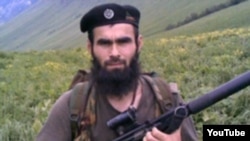The Russian Defense Ministry is planning crash courses to train large numbers of snipers -- and train them fast, according to the Russian dailies "Rossiiskaya gazeta" and "Izvestiya."
Beginning on December 1, training courses for snipers selected from the most promising conscripts will begin in four of Russia's six military districts.
The courses will last just three months, which experts consider far too little. Institute for Military Forecasting Director Anatoly Tsyganok, himself a former member of the Interior Ministry special purpose troops (spetsnaz), was dismissive, telling "Izvestiya" that training a good sniper takes far longer.
He said that graduates of the three month training course "won't be snipers, just rank-and-file soldiers capable of shooting at a distance of 400-500 meters. A real sniper can hit a target at 1.5 kilometers. To be able to do that, the Alpha division trains its snipers for three years, and the presidential security force for two years," Tsyganok said.
But Russia's top brass apparently wants quantity, not quality, and the sooner the better.
By 2016, they plan to deploy a total of 1,000 snipers to motorized rifle and tank brigades who would be capable of felling an enemy at a distance of 1--2 kilometers.
The next generation of snipers will be recruited from among contract servicemen, and undergo a longer period of training.
A Gun For All Seasons
The snipers will be issued with the classic Dragunov SVD 7.62-millimeter and VS 9-millimeter rifles.
This represents a reversal of the decision earlier this year to halt production of the Dragunov, which is considered inferior to NATO issue rifles.
The Dragunov does, however, have the advantage of functioning perfectly in adverse weather conditions, which could explain its popularity among Chechen resistance fighters.
The big unanswered question is precisely what kind of situation the Russian snipers are being trained for.
Snipers with just three months training behind them are likely to prove useless in "hot spots" such as the mountains of the North Caucasus.
They would, however, be useful in urban warfare. Snipers played an important role in the successive battles for Grozny in 1994-1999.
Sharpshooters could also be deployed in the event of mass demonstrations (when a few judicious sniper shots could send protesters fleeing into the arms of riot police), riots, or an Arab Spring type uprising.
Which of those scenarios the Kremlin considers a real enough threat to launch the new training program is anybody's guess.
-- Liz Fuller
Beginning on December 1, training courses for snipers selected from the most promising conscripts will begin in four of Russia's six military districts.
The courses will last just three months, which experts consider far too little. Institute for Military Forecasting Director Anatoly Tsyganok, himself a former member of the Interior Ministry special purpose troops (spetsnaz), was dismissive, telling "Izvestiya" that training a good sniper takes far longer.
He said that graduates of the three month training course "won't be snipers, just rank-and-file soldiers capable of shooting at a distance of 400-500 meters. A real sniper can hit a target at 1.5 kilometers. To be able to do that, the Alpha division trains its snipers for three years, and the presidential security force for two years," Tsyganok said.
But Russia's top brass apparently wants quantity, not quality, and the sooner the better.
By 2016, they plan to deploy a total of 1,000 snipers to motorized rifle and tank brigades who would be capable of felling an enemy at a distance of 1--2 kilometers.
The next generation of snipers will be recruited from among contract servicemen, and undergo a longer period of training.
A Gun For All Seasons
The snipers will be issued with the classic Dragunov SVD 7.62-millimeter and VS 9-millimeter rifles.
This represents a reversal of the decision earlier this year to halt production of the Dragunov, which is considered inferior to NATO issue rifles.
The Dragunov does, however, have the advantage of functioning perfectly in adverse weather conditions, which could explain its popularity among Chechen resistance fighters.
The big unanswered question is precisely what kind of situation the Russian snipers are being trained for.
Snipers with just three months training behind them are likely to prove useless in "hot spots" such as the mountains of the North Caucasus.
They would, however, be useful in urban warfare. Snipers played an important role in the successive battles for Grozny in 1994-1999.
Sharpshooters could also be deployed in the event of mass demonstrations (when a few judicious sniper shots could send protesters fleeing into the arms of riot police), riots, or an Arab Spring type uprising.
Which of those scenarios the Kremlin considers a real enough threat to launch the new training program is anybody's guess.
-- Liz Fuller
